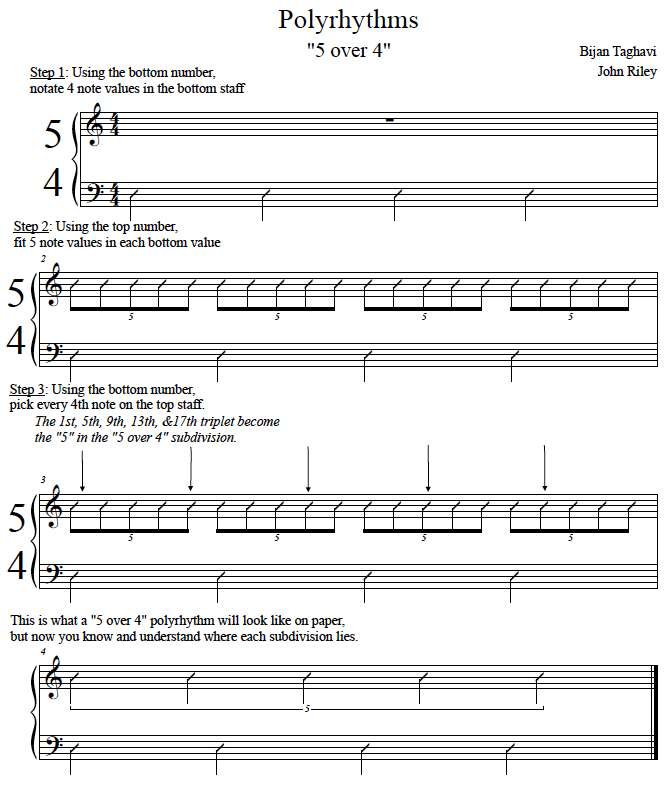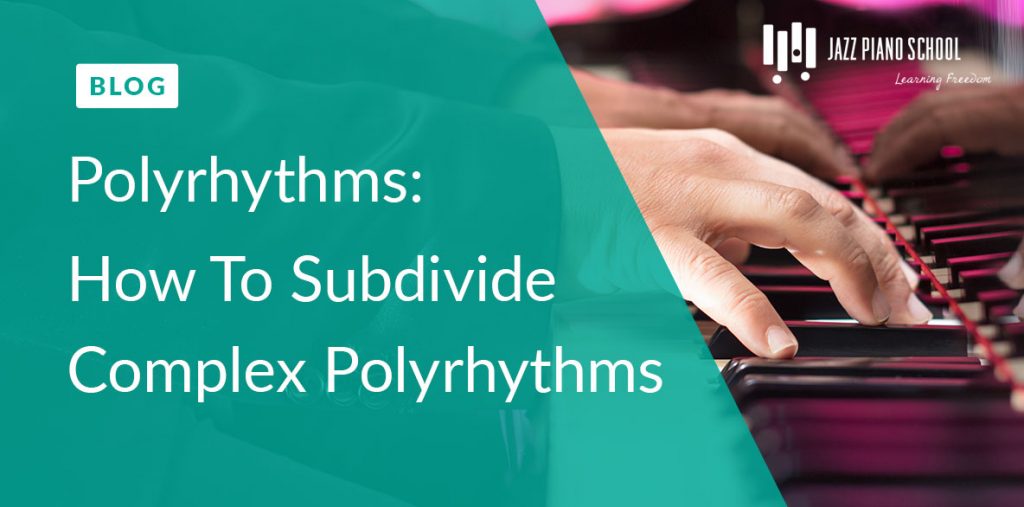Last year I had the incredible fortune of taking John Riley’s rhythmic analysis class at the Manhattan School of Music. John is an incredible player and educator, with an immense knowledge of rhythm. One lesson that resonated with me was his explanation as to how to mathematically figure out exactly where to place the subdivisions in complex polyrhythms; such as “9 over 2”, “7 over 3”, or “5 over 4”.
While I am not encouraging to be consciously thinking about this in the moment while you are performing, it is helpful to process this in the practice room to truly get an honest sense of polyrhythms and superimposing rhythms.
Check out this 3-step process, where I use the polyrhythm “5 over 4” as an example:

1) Step 1: Using the bottom number, notate 4 note values in the bottom staff

2) Step 2: Using the top number, fit 5 note values in each bottom value

3) Step 3: Using the bottom number, pick every 4th note on the top staff.
a. The 1st, 5th, 9th, 13th, &17th triplet become the “5” in the “5 over 4” subdivision.

This is what a “5 over 4” polyrhythm will look like on paper, but now you know and understand where each subdivision lies.

Hope this can inspire further creativity improvisationally or compositionally, or just further your awareness of polyrhythms.
Bijan Taghavi is a pianist, composer, and educator currently based in New York, NY. For more information visit http://www.BijanJazz.com.













3 Responses
Yes – this is the best way to understand
Using subdivision on top and pulse on the bottom to construct any polyrhythmic phrase
See the book, “POLYMETRICS” by Dr. Richard Niles & Gary O’Toole. Gary is a great British drummer who tours with Steve Hackett. We got together to write a book to explain polymeter/polyrhythm to non-drummers. It is a systematic and enjoyable approach with an accompanying CD.
Available from: http://sendmemusic.com/richard-niles-and-gary-o-toole-polymetrics.html
Gwilym Simcock, Pat Metheny’s pianist said, “In this book, Richard Niles and Gary O’Toole use their immense experience and practical music knowledge to explore the boundaries of rhythmic improvisation in a disarming and inspiring way that, as the best musical aids do, serves as an exciting springboard for the musician to go on and find his or her way through this fascinating subject.”
Nearly all the musical examples are 2 or 4 bars in length, using harmony derived from standard jazz or blues ‘turnarounds’ or modal scales and can serve as good taking-off points for improvisation and composition.. Pianists can attempt to play them on their own; other instrumentalists can play them as duets or record one part and play the other part. Programmers might want to program them. This book will help you learn to improvise polymetrically, enabling you to become one of those few players to achieve facility at filling a specific number of bars with an interesting polymetric phrase. It also provides a methodology for composers to create polymetric music.
i worked that out with 5 rh , 4 lh, 3 rf. but can only play the beats. can’t do anything with it. haven’t given drums any attention lately but would love to some day develop some independence with that. btw 2 with the left foot is harder than you would think with a 4 already going on in the lh.